Basic Approach to Occupational Safety and Health Initiatives
The UBE Group strives to keep occupational accidents to zero by making operations inherently safe. The Group’s efforts are designed to foster a safety-driven corporate culture and to reduce risks by enhancing safety initiatives and making continuous improvements. In the area of occupational health, each business site establishes an occupational safety and health management system to maintain and improve corporate activities. The UBE Group also endeavors to ensure the mental and physical health of employees by improving lifestyle habits through health checkups and follow-up care as well as various measures such as mental health consultations.
Initiatives to Prevent Occupational Accidents
Fostering a Safety-Driven Corporate Culture
To make existing safety activities more comprehensive and effective, in fiscal 2016 we launched initiatives aimed at fostering a safety-driven corporate culture, encompassing eight elements. These are organizational governance, positive involvement, resource management, work management, motivation, learning and knowledge transmission, risk perception, and mutual understanding. In keeping with findings from assessments based on headquarters’ evaluation standards, business sites identify issues and formulate and execute plans to cultivate a safety culture as part of ongoing improvement efforts.
Eliminating Major Disasters
We have undertaken a range of activities to prevent occupational accidents. In fiscal 2018, we initiated efforts that centered on eliminating major incidents. We conduct risk assessments of work that is highly susceptible to serious accidents. We implement systematic risk reduction measures and endeavor to make operations inherently safe. From fiscal 2020, we undertook safety activities with partner companies* adding safety education and training from fiscal 2021 as a priority item.
We investigate the causes of all incidents regardless of whether they result in lost time, striving to prevent similar incidents by assessing and rolling out measures.
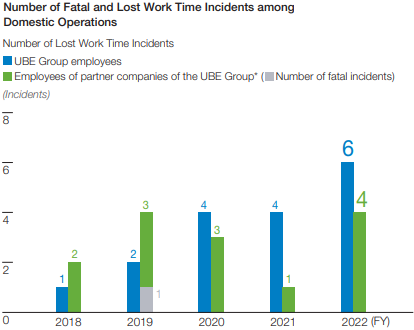
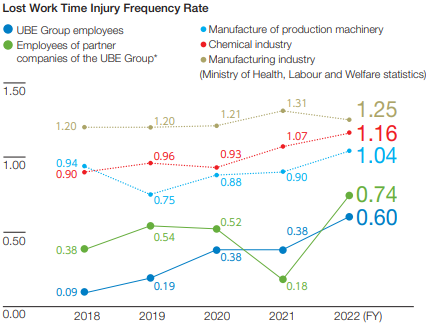
* Partner companies: Including construction and other contractors
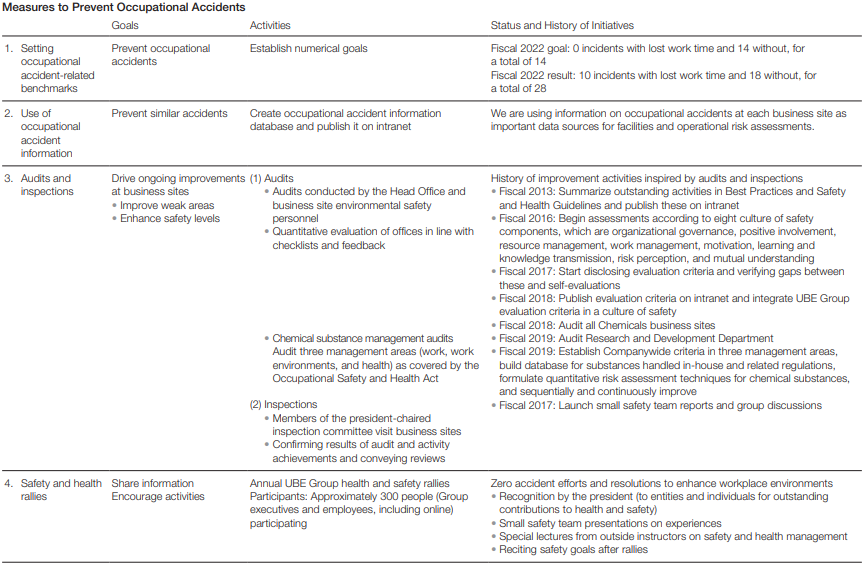
Initiatives on Safety and Health
UBE Group Safety and Health Rally
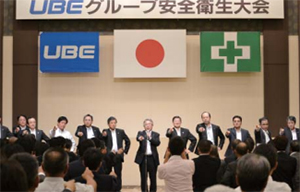
The UBE Group holds a safety and health rally every year. About 300 UBE Group officers and employees as well as business partners from across Japan participate, sharing information and fostering motivation. In addition, individuals and groups that have made particularly outstanding contributions to safety and health receive recognition from the company president. The event also features presentations from small safety groups on their experiences and special lectures from outside instructors about safety and health management, helping to raise safety awareness.
At the end of the rally, all participants, including officers, join together in reciting the Group’s safety pledge, renewing their commitment to eliminating accidents and improving work environments.
Occupational Safety and Health Council
This is a forum in which representatives of the Companywide union and UBE’s occupational safety and health officers gather to review annual occupational safety and health results and plans for the new fiscal year and discuss requests from both sides. Participants share prevailing issues and discuss ways to address them. We reflect forum results in the following year’s plans. Many major accidents have occurred among subcontractors. Labor representatives and management recognize the importance of coordinating better with those firms. Our annual plans accordingly include measures to foster safety activities with subcontractors.
Labor-Management Councils
Following Occupational Health and Safety Council discussions with Companywide union representatives, regional business sites convene gatherings to discuss local union and management requests.
Initiatives for Health Management
Health and Productivity Management Initiatives at Ube Industries
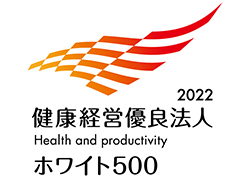
As part of its health and productivity management initiatives, Ube Industries has issued a Health and Productivity Management Declaration and announced a slogan, “A healthy mind and body: health and productivity management is for everyone,” to foster a health-focused corporate culture and create an environment that makes it easy for employees to promote their own health. The Company also provides e-learning programs for all employees to raise their awareness of health. Approximately 97% of employees have participated in the programs.
Ube Industries undertakes various health measures with a commitment to “conserving and improving employee health as an investment for future profitability,” which reflects the health management philosophy recommended by the Ministry of Economy, Trade and Industry (METI). The Company also has participated in METI’s Survey on Health and Productivity Management since 2015 as an objective evaluation index. In fiscal 2020, Ube Industries was certified under the large enterprise category of the Certified Health & Productivity Management Outstanding Organization Recognition Program for 2021.
In fiscal 2021, Ube Industries was selected for inclusion in the “White 500” list of the top-ranked 500 companies in Japan, based on results of the Survey on Health and Productivity Management. Going forward, the Company will continue to improve its internal health management programs to maintain “White 500” status.
Health Management Promotion Framework
- The UBE Group’s key policies and measures relating to health management are priority management issues. The President and CEO chairs the Strategic Management Meeting, which deliberates and decides upon these issues. Progress is managed by classifying issues into those to be addressed by Ube Industries and those to be addressed by the UBE Group.
- The annual and the medium-to-long term company-wide shared priority action items deliberated by the Strategic Management Meeting are promoted through bodies such as the Health Management Implementation Committee, the Meeting of Occupational Health Physicians, and the Meeting of Public Health Members in order to enable employees to maintain and promote their own physical and mental health.
- Each business site appoints a health manager to maintain and manage a comfortable working environment and maintain and promote the health of employees.
- Ube Industries conducts audits of the departments responsible for health management once a year as a general rule. These audits confirm that (1) industrial health measures at each business site are implemented in accordance with the Industrial Safety and Health Act and other laws and regulations, and (2) the autonomous initiatives of business sites are in line with the company-wide industrial health management plan.
Each business site implements activities using Plan-Do-Check-Act (PDCA) cycles in order to ensure continuous improvement of health management.

Policies and Issues
The Strategic Management Meeting sets out the medium-to-long term targets (policies and issues) and the priority action items, and implements five items at each Ube Industries business site and two items at each of the in-house companies. The table shows the medium-to-long term policies and issues.
| Medium-to-Long Term (FY2019 – 2021) | |
|---|---|
| Policies |
|
| Issues | Promote improvements in workplace environment (curb number of work days lost due to non-occupational injuries and illness)
|
Fiscal 2020 Priority Issues and Results
1. Measures to Address Mental Health
Ube Industries has set the goal of curbing the increase in the number of work days lost due to non-occupational injuries and illness as a medium-to-long term health issue. In terms of measures to address mental health, the Company aims to reduce presenteeism by promoting workplace improvement activities using stress check findings. Ube Industries actively uses mobile consulting services from an outside employment assistance program (EAP) to identify the strengths and weaknesses of its workplaces and implements improvements to increase the sense of unity in the workplace. This will improve engagement with work, thereby preventing the persistence of poor health and decline in productivity due to illness. Ube Industries has set a target of at least 95% for the stress check uptake rate. As for the issue of presenteeism, the Company also has set targets for “the number of departments with stress check total health risk values of 120 and higher” and “the percentage of high-stress individuals in stress check” calling for a reduction in each compared to the previous fiscal year. Moreover, in terms of measures to reduce absenteeism, the Company implements a factor analysis concerning the nature of the illness and the case (for example, personal attributes, workplace attributes) for individuals with mental health issues on leave for one month or longer and provides multifaceted support (the individual’s superiors and human resources staff, in-house specialists, and outside EAP). Ube Industries has set targets for new case rate and mental health severity rate calling for a reduction in each compared to the previous fiscal year, and a target of 50% or higher for the return to work rate.
The department responsible for company-wide health management checks on the progress of the management indicators and monitors business site activities to maintain a consistent level of in-house action. The table shows the results for the priority issues in measures to address mental health.
| Priority Issues | Item | Targets | 2016 | 2017 | 2018 | 2019 | 2020 |
|---|---|---|---|---|---|---|---|
| Promote workplace improvement activities using stress check findings | Stress check uptake rate (%) | 95% or higher | 97.1 | 96.7 | 97.0 | 97.2 | 96.9 |
| Number of departments with stress check total health risk values of 120 and higher | Reduce compared to the previous fiscal year | - | - | 35 | 43 | 34 | |
| Percentage of high-stress individuals*1) in stress check | Reduce compared to the previous fiscal year | 11.5 | 11.2 | 11.7 | 11.6 | 10.3 | |
| Reduce the number of employees on long-term leave | New case rate (%) | Reduce compared to the previous fiscal year | 0.27 | 0.57 | 0.59 | 0.55 | 0.47 |
| Mental health severity rate (%) | Reduce compared to the previous fiscal year | 0.60 | 0.59 | 0.70 | 0.76 | 0.73 | |
| Return to work rate (%) | 50% or higher | 47.1 | 48.9 | 50.0 | 31.8 | 61.0 |
*1) As stipulated in the Stress Check Guidelines (revised August 2018), Ministry of Health, Labour and Welfare
2. Use of Health Checkup Findings (Measures to Address Cerebral and Cardiac Disease and Cancer Risk)
To curb the increase in the number of work days lost due to non-occupational injuries and illness, Ube Industries is building a system to identify the risk of cerebral and cardiac disease, reduce the abnormal findings rate, and detect and treat cancer early using health checkup findings.
Specifically, health risk classifications have been introduced for all employees as a risk communication tool. This tool encourages employees to engage in health activities autonomously, provides information that enables managers to understand the health management of their subordinates, and provides the motivation to create a healthy and comfortable workplace for all employees. The diagram below shows the relationship between health classifications, work restrictions, and health risk classifications.
 Health risk classifications
Health risk classifications
In order to make better use of the risk communication tool, Ube Industries provides e-learning on self-healthcare obligations and duty of care for all employees, always striving to foster a health-focused corporate culture. The Company provides training for managers based on guidance for using the findings of employee health checkups and has established a system that enables appropriate information management.
Ube Industries has set a target of 100% for the regular health checkup uptake rate and a target for the complete checkup uptake rate (cerebral and cardiac disease and cancer) calling for an increase compared to the previous fiscal year. For the rate of high-risk individuals according to Ube Industries criteria, the Company has set a target calling for a reduction compared to the previous fiscal year. For the secondary screening rate for cancer, the Company has set a target calling for a reduction compared to the previous fiscal year. The Company checks the minutes of the meetings held at business sites to evaluate improvement, and confirms the evaluation of measures in audits in addition to applying good practices to other business sites.
The table shows the results for the priority issues in the use of health checkup findings.
| Priority Issues | Item | Targets | 2016 | 2017 | 2018 | 2019 | 2020 |
|---|---|---|---|---|---|---|---|
| Identify risk of cerebral and cardiac disease using health checkup findings and reduce abnormal findings rate | Regular health checkup uptake rate (%) | 100% | 99.6 | 99.7 | 100 | 100 | 100 |
| Complete checkup uptake rate (%) | Increase compared to the previous fiscal year | 93.8 | 92.7 | 93.5 | 98.6 | 98.8 | |
| Rate of high-risk individuals according to Ube Industries criteria (%) | Reduce compared to the previous fiscal year | 7.5 | 7.6 | 7.7 | 7.2 | 8.8 | |
| Detect and treat cancer early using health checkup findings | Secondary screening rate for cancer (%) | Increase compared to the previous fiscal year | 84.2 | 88.1 | 87.5 | 96.8 | 89.9 |
Each business site implements a variety of initiatives throughout the year to provide support for employees to take action on their health on their own. The Pre-checkup Challenge provides an opportunity for employees to reflect on their lifestyle habits before the health checkup. In addition, various evens for employees have also been conducted. These include walking rallies as well as physical strength measurements, bone density measurements, blood vessel age measurements, and practical training using breast cancer screening models. Through these health care initiatives that are targeted for all employees regardless of age and gender, Ube Industries encourages them to balance work and life in a fulfilling manner. Ube Industries has set targets for the percentage of employees with appropriate body weight and the percentage of employees who regularly exercise*2 calling for an increase in each compared to the previous fiscal year.
| Item | Targets | 2016 | 2017 | 2018 | 2019 | 2020 |
|---|---|---|---|---|---|---|
| Percentage of employees with appropriate body weight (%) | Increase compared to the previous fiscal year | 70.3 | 69.5 | 67.9 | 67.3 | 66.7 |
| Percentage of employees who regularly exercise*2) | Increase compared to the previous fiscal year | 26.8 | 27.0 | 28.2 | 28.4 | 31.0 |
*2) Regularly exercise: Engaging in at least 30 minutes of exercise at least twice a week
3. Measures to Address Tobacco Use
Ube Industries implements measures to address tobacco use with the aim of maintaining and improving the health of the UBE Group employees. The Company regards eliminating passive smoking in the workplace as a priority issue and has set targets of a 23% or lower smoking rate and a zero passive smoking rate. To achieve these targets, the Company has set out the UBE Guidelines on Measures to Address Tobacco Use. In accordance with the Guidelines, the Company takes a three-pronged approach which consists of working (1) to prevent passive smoking by creating comfortable workplaces and improving site management, (2) to prevent smoking by making it difficult to access to tobacco products and creating an environment that discourages employees to become new smokers, and (3) to support smoking cessation by providing support for smokers. Specifically, to prevent passive smoking, each business site and Group company has prepared a plan for achieving zero passive smoking and is implementing initiatives to achieve its plan. These initiatives include setting up smoking areas and checking on smoking during working hours. The departments responsible for health management conduct audits to confirm progress on eliminating passive smoking. In terms of measures to address prevention of smoking, the Guidelines promote the creation of an environment that discourages employees to become new smokers and have prohibited the sale of tobacco products on Company premises. In particular, the Company provides education for underage and newly hired employees to prevent them from becoming new smokers.
In terms of support for smoking cessation, the Company work with the health insurance association to provide employees who want to quit with assistance and support so they can quit smoking. The table shows the results for the smoking rate in measures to address tobacco use.
| Priority Issues | Item | Targets (FY2021) |
2016 | 2017 | 2018 | 2019 | 2020 |
|---|---|---|---|---|---|---|---|
| Zero passive smoking | Smoking rate (%) | 23% or less | 28.6 | 28.5 | 27.2 | 25.9 | 23.6 |
4. Measures to Address Occupational Illness Risks
In order for the UBE Group to continually improve the three areas of management under the Industrial Safety and Health Act (working environment management, work management, and health management), the Company ensures that work records, working environment measurement results, and special health checkup recipient lists are closely linked. The Company has established Guidelines for health impact assessment, Development Standards of Routine Operations for Chemical Substances Management in Three Areas, and Operational Rules for Chemical Substances Management in Three Areas, and selects employees who are eligible for special health checkups accordingly. The findings of checkups, the results of working environment measurements, and work records are shared with industrial physicians to achieve 100% implementation of appropriate occupational illness risk determinations. With regard to UBE Group companies, the Company conducts audits of the departments responsible for health management at Group companies to confirm implementation of appropriate occupational illness risk determinations.
Employee Education
The UBE Group provides a variety of training and information at its workplaces based on its belief that employees’ own actions are the key to optimal health management. Ube Industries regularly provides training on the use of health information to its managers (including managers at sites outside Japan). The objective of this training is to utilize information from health checkup findings (health risk classifications, etc.) presented by the health management department to undertake appropriate safety considerations, including employment measures, in accordance with laws and regulations, such as the Industrial Safety and Health Act. By using information on health checkup findings, the Company will continue to create an environment that enables employees to work in good health throughout their careers. The Company also disseminates information on health through the 3-minute health advice program to foster awareness of health. The table below shows a list of company-wide shared health education. In addition, each business site and Group company holds seminars aimed at improving lifestyle habits, including lectures on hygiene by industrial physicians and training on mental health by an outside EAP, striving to increase awareness of health. Employee participation events include workplace walking rallies and health festivals (which have been canceled for recent years due to the COVID-19 pandemic.)
| Training | Eligible Employees | Fiscal 2020 Results |
|---|---|---|
| Grade-specific training on mental health | Newly hired employees and employees hired mid-career at Ube Industries | Total: 473 employees |
| Training on use of health information | Managers at Ube Industries (includes managers at sites outside Japan) | Attendance rate: 97%, attended by 1,648 employees in total |
| Provision of Information | Eligible Employees | Fiscal 2020 Results |
|---|---|---|
| Information on mental health | UBE Group | 24 times a year, posted on intranet |
| 3-minute health advice | UBE Group | Provided in Safety and Health Committees held at each business site |
| Information on COVID-19 | UBE Group | Posted information on infection control measures, vaccination, health management while teleworking, etc. |
Response to Global Health Issues
Since the UBE Group’s business spans the globe, the Group complies with applicable laws and regulations in and outside Japan. As part of this, employees with work assignments outside Japan are required to receive health checkups.
Health checkup before departing Japan: Employees with three-month or longer assignments outside Japan
Health checkup after returning to Japan: Employees working in Japan after working outside Japan for six months or longer
In interventions following health checkups before departing Japan (including employment decisions), industrial physicians provide health education (including for family members if desired) and guidance on appropriate vaccinations in light of the risk of infection from malaria, AIDS, tuberculosis, etc., in each area where employees are assigned to work.